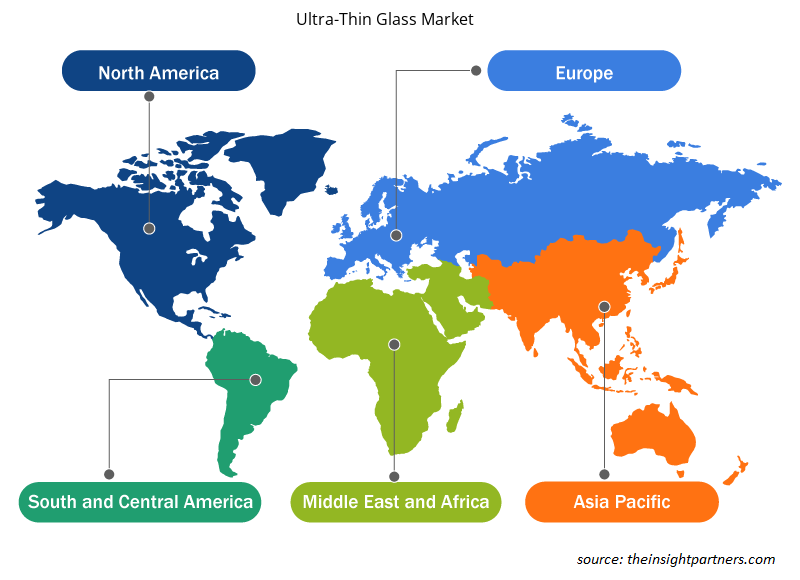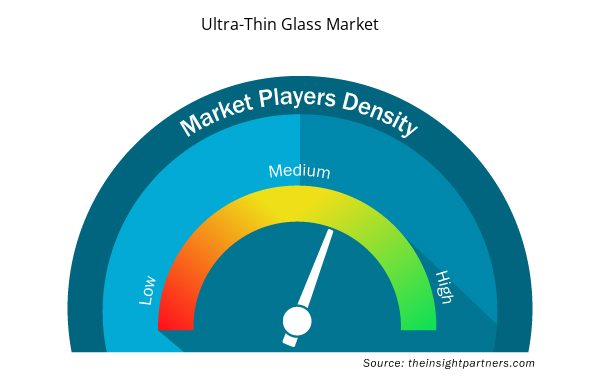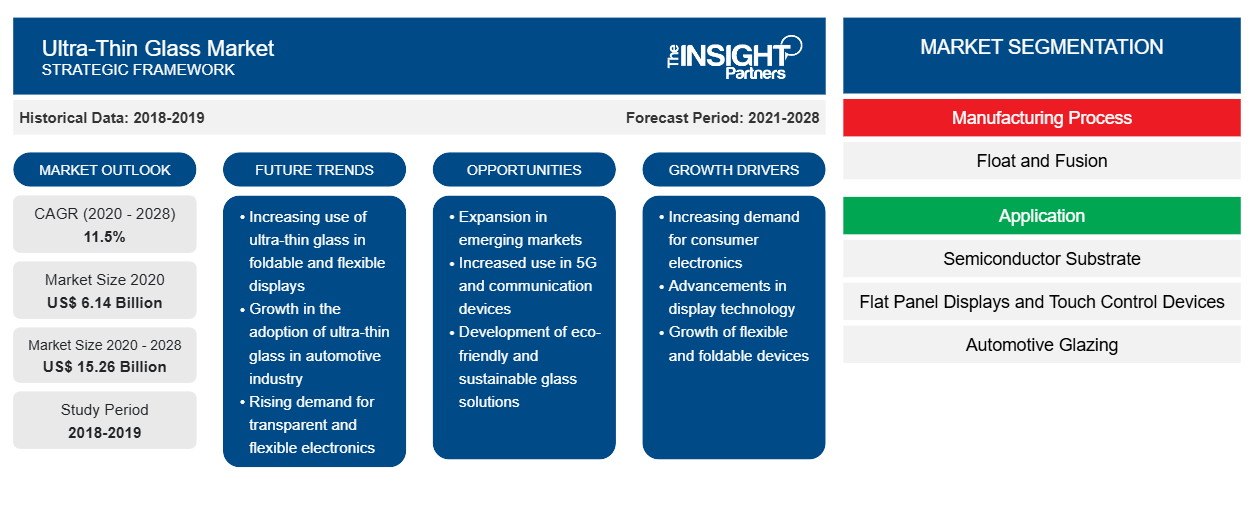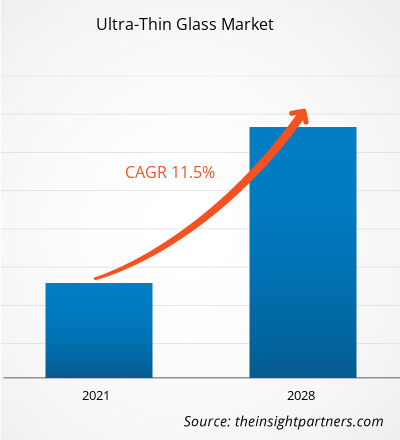[研究报告] 2020年超薄玻璃市场价值为61.3956亿美元,预计到2028年将达到152.6474亿美元;预计2021年至2028年的复合年增长率为11.5%。
超薄玻璃是指厚度低于 1 至 2 毫米的玻璃。通常使用离子交换化学强化来增强用于高科技应用的超薄玻璃。硬化超薄玻璃具有耐刮擦性,可弯曲至几毫米的半径。超薄玻璃具有耐腐蚀、透明、柔韧性、优异的气密性和防水性以及高抗冲击性等特性,适用于平板显示器、汽车玻璃等各种应用。2020 年,亚太地区占据全球超薄玻璃市场的最大收入份额。中国是超薄玻璃的最大消费国,占亚太地区市场份额的 50% 以上。该国是所有类型消费电子产品的主要制造中心,例如智能手机和液晶显示器。
持续的 COVID-19 疫情彻底改变了化学品和材料行业的现状,并对超薄玻璃市场的增长产生了负面影响。为抗击新型冠状病毒传播而采取的措施加剧了形势,并对多个行业的增长产生了负面影响。由于国家和国际边界突然关闭,汽车和消费电子等行业受到运营效率突然扭曲和价值链中断的负面影响。多个行业增长的下滑对全球市场对超薄玻璃的需求产生了负面影响。然而,随着各经济体计划恢复运营,预计未来几年全球对超薄玻璃的需求将上升。由于疫情,远程工作文化和在线教育的采用正在增长。因此,对笔记本电脑、智能手机和其他电信设备等产品的需求正在增长。预计预测期内,汽车和消费电子等各个行业对超薄玻璃的需求不断扩大,以及知名制造商的大量投资将推动超薄玻璃市场的增长。
定制此报告以满足您的需求
您可以免费定制任何报告,包括本报告的部分内容、国家级分析、Excel 数据包,以及为初创企业和大学提供优惠和折扣
- 获取此报告的关键市场趋势。这个免费样品将包括数据分析,从市场趋势到估计和预测。
市场洞察
消费电子行业蓬勃发展
随着智能手机、笔记本电脑、电视和其他电子产品等电子设备的使用不断增加,消费电子行业正在蓬勃发展。消费电子产品已成为科技世界中的必需品。各个年龄段的人都在某种程度上依赖智能手机、智能手表和笔记本电脑。随着消费电子行业的不断发展,制造商不断专注于提供先进和高质量的产品。超薄玻璃在消费电子行业中发挥着重要作用。它用于触摸和显示面板、传感器和摄像系统。超薄玻璃的各种特性,例如耐腐蚀、透明、柔韧性和气体阻隔能力,使其适用于消费电子行业的众多应用。中国在消费电子产品行业占据主导地位。该国是平板显示器的主要制造商之一。对中国智能手机、健身追踪器、电视和其他电子产品的需求迅速增长,这为超薄玻璃制造商提供了有利可图的机会。中国加强了新基础设施建设;推动人工智能、工业互联网和物联网建设;并加速5G商用步伐,推动电子信息制造业进入新的发展阶段,进一步推动相关产业向高端发展。根据世界人口评论,中国有16亿手机用户,印度有12.8亿手机用户。2018年,苹果智能手表出货量约2250万台,较2017年有所增长,2017年出货量为1770万台。2018年,Fitbit智能手表出货量约550万台,三星出货量约530万台。因此,消费电子行业的快速增长带动了超薄眼镜的需求
最终用途行业洞察
2020 年,消费电子领域占据全球超薄玻璃市场的最大份额。超薄玻璃广泛用于制造电子产品,例如用于各种设备的平板显示器和触摸屏显示器,例如 LCD、OLED、智能手机和可穿戴设备。随着全球对创新和技术先进的电子产品的需求不断增长,预计未来几年对超薄玻璃的需求将大幅增加。
制造过程洞察
从制造工艺来看,2020 年熔合玻璃在收入方面占据了超薄玻璃市场的主导地位。熔合工艺通常被称为溢流下拉法,广泛用于制造用于显示面板的平板超薄玻璃。康宁是第一家制造悬浮在半空中的特种玻璃的公司,这是熔合法的一个关键特征。玻璃不与熔融金属接触,这是熔合法相对于浮法玻璃的一个根本优势。
超薄玻璃市场的一些主要市场参与者包括康宁公司、旭硝子株式会社、日本电气硝子株式会社、肖特股份公司、中央硝子株式会社、南玻集团股份有限公司、Emerge Glass、日本板硝子株式会社、信义硝子控股有限公司和洛阳玻璃有限公司。市场的主要参与者正在采用并购和产品发布等策略来扩大其地理覆盖范围和消费者基础。
超薄玻璃市场区域洞察
Insight Partners 的分析师已详尽解释了预测期内影响超薄玻璃市场的区域趋势和因素。本节还讨论了北美、欧洲、亚太地区、中东和非洲以及南美和中美洲的超薄玻璃市场细分和地理位置。

- 获取超薄玻璃市场的区域具体数据
超薄玻璃市场报告范围
| 报告属性 | 细节 |
|---|---|
| 2020 年市场规模 | 61.4亿美元 |
| 2028 年市场规模 | 152.6亿美元 |
| 全球复合年增长率(2020 - 2028) | 11.5% |
| 史料 | 2018-2019 |
| 预测期 | 2021-2028 |
| 涵盖的领域 | 按制造工艺
|
| 覆盖地区和国家 | 北美
|
| 市场领导者和主要公司简介 |
|
市场参与者密度:了解其对商业动态的影响
超薄玻璃市场正在快速增长,这得益于终端用户需求的不断增长,而这些需求又源于消费者偏好的不断变化、技术进步以及对产品优势的认识不断提高等因素。随着需求的增加,企业正在扩大其产品范围,进行创新以满足消费者的需求,并利用新兴趋势,从而进一步推动市场增长。
市场参与者密度是指在特定市场或行业内运营的企业或公司的分布情况。它表明相对于给定市场空间的规模或总市场价值,有多少竞争对手(市场参与者)存在于该市场空间中。
在超薄玻璃市场运营的主要公司有:
- 康宁公司
- AGC公司
- 日本电气硝子株式会社
- 肖特公司
- 中央玻璃有限公司
免责声明:上面列出的公司没有按照任何特定顺序排列。

- 了解超薄玻璃市场主要参与者概况
报告亮点
- 超薄玻璃行业的进步趋势,帮助参与者制定有效的长期战略
- 公司采用的业务增长战略来确保发达市场和发展中市场的增长
- 2019年至2028年全球超薄玻璃市场定量分析
- 各行业对超薄玻璃的需求估计
- 波特分析说明了行业内买家和供应商预测市场增长的有效性
- 了解竞争激烈的市场形势和超薄玻璃的需求的最新发展
- 市场趋势和前景,以及推动和抑制超薄玻璃市场增长的因素
- 了解全球超薄玻璃市场增长的商业利益战略,有助于决策过程
- 超薄玻璃市场各节点规模
- 全球超薄玻璃市场的详细概述和细分以及其行业动态
- 各地区超薄玻璃市场规模及增长机遇
超薄玻璃市场(按制造工艺划分)
- 漂浮
- 融合
超薄玻璃市场(按应用划分)
- 半导体基板
- 平板显示器和触摸控制设备
- 汽车玻璃
- 其他的
超薄玻璃市场(按最终用途行业划分)
- 消费电子产品
- 汽车
- 医疗保健
- 其他的
公司简介
- 康宁公司
- AGC公司
- 日本电气硝子株式会社
- 肖特公司
- 中央玻璃有限公司
- 中国南玻集团股份有限公司
- 出现玻璃
- 日本板硝子株式会社
- 信义玻璃控股有限公司
- 洛阳玻璃有限公司
- 历史分析(2 年)、基准年、预测(7 年)及复合年增长率
- PEST 和 SWOT 分析
- 市场规模价值/数量 - 全球、区域、国家
- 行业和竞争格局
- Excel 数据集



Report Coverage
Revenue forecast, Company Analysis, Industry landscape, Growth factors, and Trends

Segment Covered
This text is related
to segments covered.

Regional Scope
North America, Europe, Asia Pacific, Middle East & Africa, South & Central America

Country Scope
This text is related
to country scope.
常见问题
Asia-Pacific is estimated to register the fastest CAGR in the market over the forecast period. The rising demand for LED and OLED televisions is boosting the market growth across the region. Manufacturers of flat panel displays in China, South Korea, and Taiwan are dominating the global marketplace in terms of production and supply of flat panel displays. These displays can be found in cars, industrial equipment, personal computers, smartphones, and a variety of other goods. Liquid crystal displays are used in the majority of TV screens (LCDs). Other display types used in televisions include organic light-emitting diodes (OLEDs) and quantum dots. LCDs and OLEDs are used in smartphone displays. Thus, the high concentration of flat panel display manufacturers in Asia-Pacific, coupled with the high utilization of ultra-thin glass in designing flat panel displays, is the crucial factor anticipated to further drive the market in the coming years. Furthermore, the growing application of ultra-thin glass by automobile manufacturers in China, India, and South Korea is driving the market. China, as one of the significant producers of automobiles, has a high need for ultra-thin glass for use in various automotive interior panels. Furthermore, the existence of significant players such as AGC Inc. and Nippon Electric Glass Co., Ltd is projected to fuel the market expansion.
Based on end use, consumer electronics segment led the global ultra-thin glass market during the forecasted period. Consumer electronics is one of the prominent end-use industries contributing a major share in the growth of the ultra-thin glass market. Ultra-thin glass is widely used to manufacture electronic goods such as flat panel display devices, smartphones, wearable devices, and touch screen devices. It is extremely thin and flexible. Therefore, it is ideal for devices with wider displays and touch screen features. Moreover, it is used in microprocessors of smartphones as a substrate. Using ultra-thin glass in semiconductor substrates ensures the increased performance of microprocessors, which enables high data transfer rates. The growing utilization of ultra-thin glass in consumer electronic devices is expected to boost the market growth. Moreover, the rising demand for electronic gadgets such as smartphones, laptops, tablets, and televisions in emerging economies, owing to rise in disposable income, significant economic development, increase in adoption of emerging technologies, and improved lifestyles of people, is expected to boost the growth of global ultra-thin glass market in the coming years. Manufacturers of ultra-thin glass are focusing on launching innovative products. Recently, foldable ultra-thin glass was developed by Schott AG which is a Germany-based manufacturer of specialty glass products. This foldable glass was used by Samsung in its Z-fold 3 smartphone which is gaining huge popularity among people worldwide. Such innovations by the prominent manufactures of ultra-thin glass are expected to boost the consumer electronics segment’s growth.
On the basis of manufacturing process, fusion segment is leading the ultra-thin glass market during the forecast period. The fusion process, often known as the overflow downdraw method, is widely used to manufacture flat ultra-thin glass for display panels. Corning was the first company to create specialized glass that was suspended in mid-air, which is a key trait of the fusion method. Glass is not contacted by molten metal, which is a fundamental advantage of the fusion method over the float glass method. The raw materials, including pure sand and other inorganic elements, are fed into a massive melting tank that is heated to temperatures beyond 1000â° Celsius. The molten glass is homogenized and conditioned before being discharged into an isopipe, a huge collection trough with a V-shaped bottom. The isopipe is carefully heated to ensure optimum viscosity of the mixture and consistent flow. The molten glass flows uniformly over the isopipe's top edges, generating two thin, sheet-like streams along the outer surfaces. The two sheets meet at the bottom of the isopipe and are fused into a single glass sheet. As the sheet lengthens and cools in mid-air, it feeds into drawing equipment while still linked to the bottom of the isopipe. With precise control of the fusion glass process parameters, thinner glass panels can be produced. Commercial manufacturers such as Corning, Schott, AGC, and Nippon Electric Glass use the drawdown or fusion process for producing ultra-thin glass.
Based on application, flat-panel display segment is expected to grow at the fastest CAGR from 2021 to 2028. Flat panel displays are video devices that replace the conventional cathode ray tube (CRT) with a thin panel design. Ultra-thin glass is widely used to manufacture flat panel displays such as LCD, LED, OLED screens, smartphone displays, and monitor screens. Moreover, ultra-thin glass is used in the touch module of touch screen devices such as smartphones, tablets, and laptops. It provides fundamental functions for flat-panel display and touch screen devices such as high definition (HD) display, touch-control and scratch resistance, and protection to the screens. Consumer electronic goods are being upgraded at a faster rate as the technological landscape is changing rapidly. Panel display components used in flat-panel display and touch-control devices have emerged as the most important downstream application products for ultra-thin glass substrates with the highest market demand. The need for ultra-thin glass substrate is predicted to rise since it is a crucial component and key fundamental material for flat-panel display and touch-control systems. Moreover, ultra-thin glass substrates are non-substitutable and have a promising future as the entire electronic device market develops.
The major players operating in the ultra-thin glass market are Corning Incorporated; AGC Inc.; Nippon Electric Glass Co., Ltd.; SCHOTT AG; Central Glass Co., Ltd.; CSG Holding Co., Ltd.; Emerge Glass; Nippon Sheet Glass Co., Ltd; Xinyi Glass Holdings Limited; and Luoyang Glass Co., Ltd.
In 2020, Asia Pacific held the largest revenue share of the global ultra-thin glass market and is also expected to register the highest CAGR during the forecast period. The ultra-thin glass market across the region is projected to witness remarkable growth, owing to the rapidly expanding consumer electronics industry in countries such as China, Japan, and South Korea. China is one of the largest consumer electronics markets across the world, along with Japan and South Korea. Due to the high concentration of consumer electronics manufacturers in Asia-Pacific, the demand for ultra-thin glass from the manufacturers of electronic goods across the region is expected to grow significantly over the forecast period. Moreover, China and Japan are the leading exporters of semiconductor components used in electronic gadgets. Many leading manufacturers of smartphones and electronic gadgets heavily rely on Asia-Pacific countries for sourcing semiconductor components. For chip packing and interposer applications, the semiconductor industry is progressively designing products using thin glass substrates. When organic substrate materials are employed, the locally generated heat of the small core parts of mobile devices causes deflection and reliability issues. Ultra-thin glass has excellent dimensional stability over a wide range of temperatures while also providing the foundation for an exceedingly flat chip package. Thus, the increasing utilization of ultra-thin glass for designing electronic goods across the region is projected to potentially drive the market over the forecast period.
Trends and growth analysis reports related to Chemicals and Materials : READ MORE..
The List of Companies - Ultra-thin Glass Market
- Corning Incorporated
- AGC Inc.
- Nippon Electric Glass Co., Ltd.
- SCHOTT AG
- Central Glass Co., Ltd.
- CSG Holding Co., Ltd.
- Emerge Glass
- Nippon Sheet Glass Co., Ltd
- Xinyi Glass Holdings Limited
- Luoyang Glass Co., Ltd.
The Insight Partners performs research in 4 major stages: Data Collection & Secondary Research, Primary Research, Data Analysis and Data Triangulation & Final Review.
- Data Collection and Secondary Research:
As a market research and consulting firm operating from a decade, we have published and advised several client across the globe. First step for any study will start with an assessment of currently available data and insights from existing reports. Further, historical and current market information is collected from Investor Presentations, Annual Reports, SEC Filings, etc., and other information related to company’s performance and market positioning are gathered from Paid Databases (Factiva, Hoovers, and Reuters) and various other publications available in public domain.
Several associations trade associates, technical forums, institutes, societies and organization are accessed to gain technical as well as market related insights through their publications such as research papers, blogs and press releases related to the studies are referred to get cues about the market. Further, white papers, journals, magazines, and other news articles published in last 3 years are scrutinized and analyzed to understand the current market trends.
- Primary Research:
The primarily interview analysis comprise of data obtained from industry participants interview and answers to survey questions gathered by in-house primary team.
For primary research, interviews are conducted with industry experts/CEOs/Marketing Managers/VPs/Subject Matter Experts from both demand and supply side to get a 360-degree view of the market. The primary team conducts several interviews based on the complexity of the markets to understand the various market trends and dynamics which makes research more credible and precise.
A typical research interview fulfils the following functions:
- Provides first-hand information on the market size, market trends, growth trends, competitive landscape, and outlook
- Validates and strengthens in-house secondary research findings
- Develops the analysis team’s expertise and market understanding
Primary research involves email interactions and telephone interviews for each market, category, segment, and sub-segment across geographies. The participants who typically take part in such a process include, but are not limited to:
- Industry participants: VPs, business development managers, market intelligence managers and national sales managers
- Outside experts: Valuation experts, research analysts and key opinion leaders specializing in the electronics and semiconductor industry.
Below is the breakup of our primary respondents by company, designation, and region:

Once we receive the confirmation from primary research sources or primary respondents, we finalize the base year market estimation and forecast the data as per the macroeconomic and microeconomic factors assessed during data collection.
- Data Analysis:
Once data is validated through both secondary as well as primary respondents, we finalize the market estimations by hypothesis formulation and factor analysis at regional and country level.
- Macro-Economic Factor Analysis:
We analyse macroeconomic indicators such the gross domestic product (GDP), increase in the demand for goods and services across industries, technological advancement, regional economic growth, governmental policies, the influence of COVID-19, PEST analysis, and other aspects. This analysis aids in setting benchmarks for various nations/regions and approximating market splits. Additionally, the general trend of the aforementioned components aid in determining the market's development possibilities.
- Country Level Data:
Various factors that are especially aligned to the country are taken into account to determine the market size for a certain area and country, including the presence of vendors, such as headquarters and offices, the country's GDP, demand patterns, and industry growth. To comprehend the market dynamics for the nation, a number of growth variables, inhibitors, application areas, and current market trends are researched. The aforementioned elements aid in determining the country's overall market's growth potential.
- Company Profile:
The “Table of Contents” is formulated by listing and analyzing more than 25 - 30 companies operating in the market ecosystem across geographies. However, we profile only 10 companies as a standard practice in our syndicate reports. These 10 companies comprise leading, emerging, and regional players. Nonetheless, our analysis is not restricted to the 10 listed companies, we also analyze other companies present in the market to develop a holistic view and understand the prevailing trends. The “Company Profiles” section in the report covers key facts, business description, products & services, financial information, SWOT analysis, and key developments. The financial information presented is extracted from the annual reports and official documents of the publicly listed companies. Upon collecting the information for the sections of respective companies, we verify them via various primary sources and then compile the data in respective company profiles. The company level information helps us in deriving the base number as well as in forecasting the market size.
- Developing Base Number:
Aggregation of sales statistics (2020-2022) and macro-economic factor, and other secondary and primary research insights are utilized to arrive at base number and related market shares for 2022. The data gaps are identified in this step and relevant market data is analyzed, collected from paid primary interviews or databases. On finalizing the base year market size, forecasts are developed on the basis of macro-economic, industry and market growth factors and company level analysis.
- Data Triangulation and Final Review:
The market findings and base year market size calculations are validated from supply as well as demand side. Demand side validations are based on macro-economic factor analysis and benchmarks for respective regions and countries. In case of supply side validations, revenues of major companies are estimated (in case not available) based on industry benchmark, approximate number of employees, product portfolio, and primary interviews revenues are gathered. Further revenue from target product/service segment is assessed to avoid overshooting of market statistics. In case of heavy deviations between supply and demand side values, all thes steps are repeated to achieve synchronization.
We follow an iterative model, wherein we share our research findings with Subject Matter Experts (SME’s) and Key Opinion Leaders (KOLs) until consensus view of the market is not formulated – this model negates any drastic deviation in the opinions of experts. Only validated and universally acceptable research findings are quoted in our reports.
We have important check points that we use to validate our research findings – which we call – data triangulation, where we validate the information, we generate from secondary sources with primary interviews and then we re-validate with our internal data bases and Subject matter experts. This comprehensive model enables us to deliver high quality, reliable data in shortest possible time.


 获取此报告的免费样本
获取此报告的免费样本